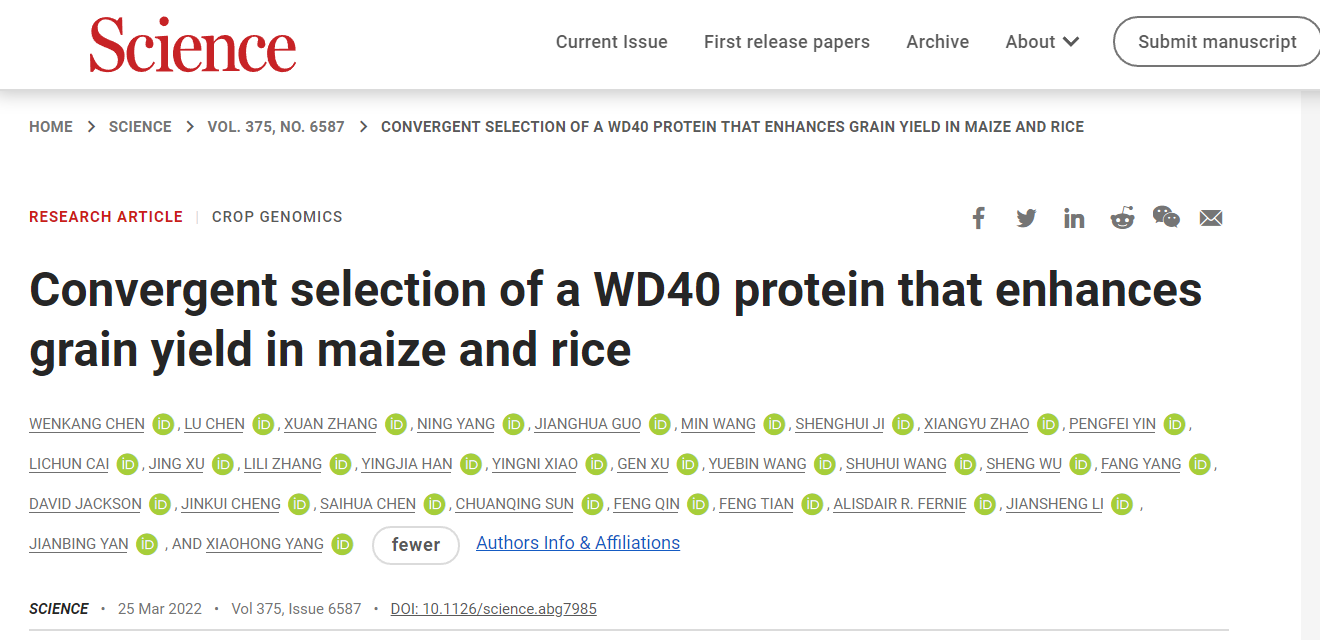A research paper entitled “Convergent selection of a WD40 protein that enhances grain yield in maize and rice” was published online in the journal Science on March 25, 2022. Conducted by the team of Yan Jianbing from HZAU and the team of Li Jiansheng and Yang Xiaohong from China Agricultural University (CAU), the research found that KRN2 in maize and OsKRN2 in rice undergo convergent selection and regulate the yield of maize and rice in similar pathways, and provided the genetic pattern of convergent selection in maize and rice by genome-wide analyses. The study has laid an important theoretical foundation for the mechanism analysis of crop domestication and future crop breeding.

The paper is published in Science.
Agricultural civilization began about 10,000 years ago, as ancient humans learned to domesticate plants and animals, and people’s lifestyle transitioned from hunting to farming. Maize, rice and wheat have been the three most successfully domesticated crops so far, providing more than 50% of the global energy intake for humans. The domestication occurred in crops of different ancestors, morphological traits and growth habits, and in different regions of the earth. What happened during the long-term improvement and selection, and did the crops follow common genetic patterns? That is a major basic scientific problem and also has important practical implications for future crop genetic improvement.

Fig. 1. Shared selected orthologous genes in maize and rice for convergent phenotypic shifts.
The joint team of CAU and HZAU has been working on the issue for 18 years, conducting systematic research at both genetic and genomic levels. They first created a specific six-row maize material with wild-type maize resources, and identified a selected gene KRN2 which regulates kernel row number in maize with genomic techniques. During the domestication and improvement of maize, selection in the noncoding upstream regions resulted in a reduction of KRN2 expression and an increased grain number through an increase in kernel rows. They also identified the rice ortholog OsKRN2, which regulates grain number via control of secondary panicle branches. The gene underwent selection during the domestication and improvement of rice, leading to a reduction of its expression. These orthologs encode WD40 proteins and function synergistically with a gene of unknown function, DUF1644, which suggests that a conserved protein interaction controls grain number in maize and rice.
Furthermore, the researchers conducted a deep analysis of the scope and mechanism of convergent selection in maize and rice on a genome-wide scale, and identified a set of 490 orthologous genes that underwent convergent selection. These genes appeared to be significantly enriched in the pathways like starch and sucrose metabolism, and biosynthesis of cofactors. Starch is the main component of energy stored in the cereal seeds. It contributes greatly to the domestication of rice and maize into major food crops and exerts a strong influence on the grain number. The research results not only help to clarify the evolution and improvement of crop species, but also provide valuable information for accelerating breeding programs and domesticating new crops.

Fig. 2. Yield performance of KRN2 and OsKRN2 gene-edited lines under field conditions.
The research used gene editing technology to create new materials with functional knockouts of KRN2 and OsKRN2. Field tests show that knockout of KRN2 in maize or OsKRN2 in rice increased grain yield by 10% and 8%, respectively, with no apparent trade-off in other agronomic traits. This suggests potential applications of KRN2 and its orthologs for crop improvement.
The co-corresponding authors of this paper are Prof. Yan Jianbing from National Key Laboratory of Crop Genetic Improvement of HZAU and Hubei Hongshan Laboratory, and Prof. Li Jiansheng and Prof. Yang Xiaohong from CAU. The co-first authors are the doctoral student Chen Lu from HZAU (now a postdoctoral student of the Institute of Genetics and Developmental Biology, Chinese Academy of Sciences) , Prof. Yang Ning from HZAU, the postdoctoral student Chen Wenkang from CAU and the doctoral student Zhang Xuan from CAU. Many other researchers participated in this program, including students from the two teams of HZAU and CAU, Chair Professor David Jackson and Prof. Yang Fang from HZAU, Prof. Chen Saihua from Yangzhou University, Prof. Sun Chuanqing, Prof. Qin Feng and Prof. Tian Feng from CAU, and Prof. Alisdair R. Fernie from Max Planck Institute of Molecular Plant Physiology. The research is supported by the National Natural Science Foundation of China (91935302, 31421005, 31961133002, and 91435205), the National Key Research and Development Program of China (2020YFE0202300) and other programs.
Source: http://news.hzau.edu.cn/2022/0325/62807.shtml
Translated by: Deng Qingqing
Supervised by: Jin Bei
